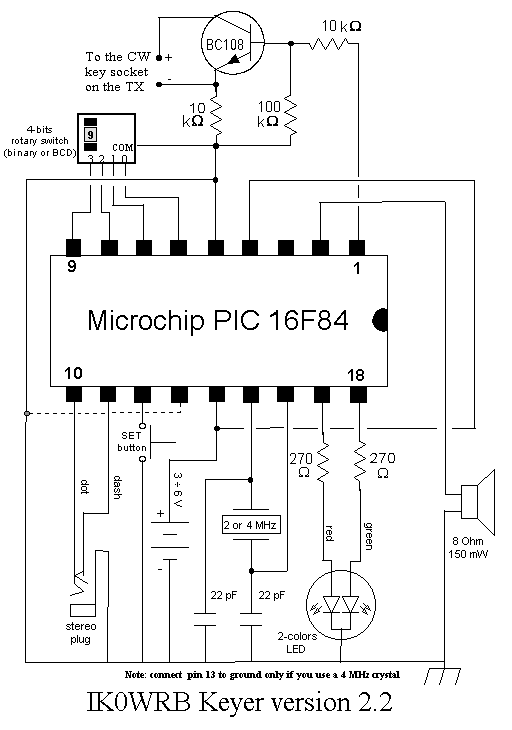What follows is the circuit of the IK0WRB Keyer version 2.2

IK0WRB Keyer version 2.2
What follows is the circuit of the IK0WRB Keyer version 2.2

- a Microchip PIC 16F84, in the 18 pins package
- a 2 MHz or 4 MHz quarz crystal, parallel resonance
- 2 capacitors of 22 pF, 15 V
- 2 resistors of 270 Ohm, 0.25 W
- a resistor of 100 kOhm, 0.25 W
- 2 resistors of 10 kOhm, 0.25 W
- a 2-colors LED, common cathod, red and green
- a button, normally open
- 2 jack sockets, 3 poles (stereo)
- a loudspeaker, 4 - 8 Ohm 150 mW
- a BC108 transistor, or similar
- a 4-bits rotary switch (contraves) either binary (0-F) or BCD (0-9)
You can download here the hex module you need to program the Microchip PIC 16F84 you need for keyer. This is the software for version 2.2 of the keyer. New versions of the circuit (and related software) may be released in the future.
The use of the keyer is basically identical to version 2.1 of the
keyer, but I totally rewrote the manipulation (iambic) routine, after some
very high speed CW enthusiasts criticised a bit my keyer. I think now iambic is
ok even for these strange chaps :-)
Due to difficulties to find 4-bits (thus
5 pins) 16-positions binary rotary switches, I mapped the positions A through E
also on positions 5 to 9, that were unused before. So now, for example, to set
audio on/off you can rotate the switch to 5 or to A, at your choice. This means
that you can now also install a 4-bits (5 pins) 10-positions BCD switch, witch
is more easy to find.
For the same market reason, I decided to support both 2
and 4 MHz quarz crystals, but for this you must tell the chip in some way (no,
wispering doesn't work...) what crystal you are using. Since I got 2 unused
pins, one of them is used now for this purpose. So, leaving pin 13 of the 16F84
free (logic 1) tells the chip that you are using a 2 MHz crystal (this is
compatible with previous versions of the circuit), while connecting pin 13 to
ground (logic 0) tells the chip that you are using a 4 MHz crystal.
All these
changes were possibile because I changed the way to compute delays for each
transmitting speed. Up to version 2.1 I used a pre-computed table stored in
program memory, but now I execute a division routine and the space occupied by
the table is now used for real istructions.
Thus I could add also a new
feature to direct mode: pressing the button will trasmit a 5 seconds carrier,
very useful for tuning.
I prolongued also the timeout for sleep mode, from
the very short 33 seconds to a more normal 2'45". This doesn't affect the way
you use the keyer, it's only a psycological trick: the keyer doesn't look dead
while listening in a CW QSO.
Finally, I measured the actual trasmitted speed
of the keyer and found it was about 9.8% slower than it should have been. Not a
real problem, but I tuned delay constants anyway.
The following table shows
how to operate the keyer version 2.2.
| Rotary switch position |
Status | LED color | Left paddle | Right paddle | SET button |
|---|---|---|---|---|---|
| 0 | Sleep | Off | No effect | No effect | No effect |
| 1 | Ready | Green while rx. Red while tx. Yellow if tx local. |
Dot | Dash | Send single CQ message |
| 2 | Speed | Yellow | Decrease speed | Increase speed | Sound current speed (Snn) |
| 3 | Weighting | Yellow | Decrease weight | Increase weight | Sound current weight (Wn or Wn.5) |
| 4 | TX | Green if disabled. Yellow if enabled. |
Enable transmitter | Disable transmitter | Sound status (TY or TN) |
| 5 or A | Audio | Green if disabled. Yellow if enabled. |
Enable audio monitor | Disable audio monitor | Sound status (AY or AN) |
| 6 or B | Beacon | Green if message present. Off if no message. |
Starts Beacon sequence. During carrier: immediate call. |
During call: go to carrier. During carrier: more carrier. |
Starts Beacon sequence. During tx or carrier: stops Beacon sequence. |
| Autostart beacon sequence at power on | |||||
| 7 or C | CQ | Green if message present. Off if no message. |
Starts CQ sequence. During pause: immediate CQ. |
During CQ: go to pause. During pause: more pause. |
Starts CQ sequence. During CQ or pause: stops sequence |
| 8 or D | Direct | Green | Carrier while pressed | Carrier while pressed | 5 seconds carrier |
| 9 or E | Enter | Green | Store a dot | Store a dash | Single pressure: insert inter-word space. 2 consecutive pressures: delete last char. |
| Store an inter-character space when pausing 0.25 sec. | |||||
| F | Sleep | Off | No effect | No effect | No effect |
[ About me
| Acronyms | CW
| Data Sheets | Docs
| Download | E-mail
| HOME | Ham
projects | Hobby
circuits | Photo galery
| PIC | QTH
photos |
Sign
in my guestbook | View
my guestbook ]
© 2001 - YO5OFH, Csaba Gajdos